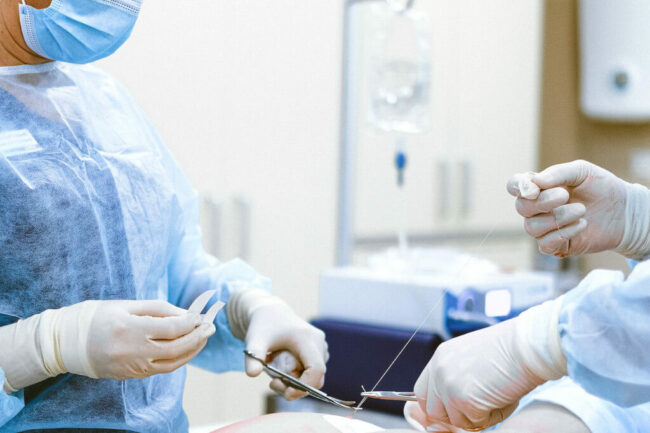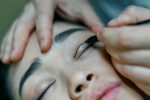Facts about Eyelid Surgery
- Eyelid surgery, or blepharoplasty, is a cosmetic surgical procedure that reduces heavy eyelids and provides an improved and fresher appearance
- If the eyelids are so heavy that they hang down in front of the pupils, then the operation can also help the vision. In the case of more severe sagging of the skin on the upper eyelid, which affects vision, surgery with skin reduction is a public task
- A distinction is made between two types of eyelid surgery, upper and lower. Upper eyelid surgery is done more often than lower
- Complications are rare
What is the purpose?
Eyelid surgery removes heavy eyelids and bags under the eyes by removing skin and tissue from the upper and lower eyelids. Only plastic surgeons or ophthalmologists are allowed to perform the procedure.
The intervention is mainly cosmetic and is therefore carried out privately. If you have pronounced excess skin on the upper eyelids and a restricted field of vision as well as a number of other problems, you can have the excess skin removed in public.
How does the operation take place?
Eyelid surgery takes about an hour, possibly more, depending on whether only one or both eyelids are to be treated. It is usually done under local anaesthetic.
Surgery does not make dark circles around the eyes disappear, but the procedure can reduce shadows formed by large bags under the eyes.
Eyelid surgery also does not remove wrinkles at the corner of the eye. It is therefore not unusual to combine the procedure with Botox , fillers and laser treatment . In some patients, the excess skin on the upper eyelids is due in whole or in part to drooping of the forehead. In these cases, the eyebrows or the entire forehead should be lifted before or at the same time as skin correction on the eyelid
Upper eyelid surgery
- Upper eyelid operations are performed significantly more often than lower eyelid operations
- An incision is usually made in a skin fold above the eye. Excess skin and perhaps muscle and fatty tissue is then removed to counteract heavy, drooping eyelids
- Eyelid surgeries can either be performed individually or in combination
- The wound is sutured with a thin thread
Lower eyelid surgery
- In lower eyelid surgery, bags under the eyes are treated by removing fatty tissue
- An incision is made on the inside of the eyelid or just below the eyelashes. Thereby the scars are hidden as best as possible. Here too, redundant skin and in some cases muscle can be removed. In some cases, the skin and muscle removal is combined with a tightening of the eyelid muscle or eyelid ligament to avoid drooping of the lower eyelid
Results
Most are very satisfied with the result.
The area around the eyes will often be discolored and swollen for 1-2 weeks. It helps to sleep with the head elevated and to cool the area around the eyes with cold compresses, especially in the hours immediately after the operation.
If cooling with ice around the eyes, this must not be applied directly to the skin, as this can cause frostbite and thus damage the tissue.
You may need to use ointment and eye drops for a short time after surgery.
After 1-2 days you are able to watch TV.
Although the result after eyelid surgery is long-lasting, the eyelids will begin to droop again as you get older.
Side effects
- It may be sensible to use a pair of large dark sunglasses in the period after the operation. Partly to camouflage the discolouration, but also to protect the discolored skin against the sun’s rays. The eyes may be more sensitive to light and feel dry, but this will go away after a few weeks
- You cannot use contact lenses until after one month
- You should expect to take 5-10 days off if you are to have eyelid surgery
- The blue eyes will disappear after a few weeks, but you should avoid activities that increase blood pressure – for example, heavy lifting
Possible complications
As with any surgery, there is some risk associated with eyelid surgery. Complications can occur but are rare. The most frequent complications are:
- Bleeding in the skin around the eyes
- Dryness in the eyes which typically disappears after a few weeks
- Decreased sensitivity of the eyelashes, which also retract
- Infection
- Inability to close the eyes. This will also go away, but you may need eye ointment to keep the eyes moist for the first time
A feared and fortunately rare complication is bleeding behind the eye. This must be detected immediately and the surgeon must carry out the appropriate treatment. Otherwise, permanent blindness may occur.
With lower eyelid surgery, the most feared side effect is drooping eyelids (ectropion). However, this can usually be corrected with a new operation. Another side effect can be that you get non-symmetrical eyes. This may be because the plastic surgeon has removed too much skin on one side. However, few people have completely identical eyes, so a slight asymmetry can be expected.
If you have glaucoma or generally dry eyes that do not produce enough tear fluid, you have a higher risk of having problems after the operation.






